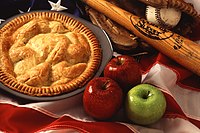
| Part of a series on |
| American cuisine |
|---|
 |
The cuisine of the Southern United States encompasses diverse food traditions of several subregions, including cuisine of Southeastern Native American tribes, Tidewater, Appalachian, Ozarks, Lowcountry, Cajun, Creole, African American cuisine and Floribbean, Spanish, French, British, and German cuisine. In recent history, elements of Southern cuisine have spread to other parts of the United States, influencing other types of American cuisine.[1]
Many elements of Southern cooking—tomatoes, squash, corn (and its derivatives, such as hominy and grits), and deep-pit barbecuing—are borrowings from Indigenous peoples of the region (e.g., Cherokee, Caddo, Choctaw, and Seminole). From the Old World, European colonists introduced sugar, flour, milk, eggs, and livestock, along with a number of vegetables; meanwhile, enslaved West Africans trafficked to the North American colonies through the Atlantic slave trade[2] introduced black-eyed peas, okra, eggplant, sesame, sorghum, melons, and various spices.[3] Rice also became prominent in many dishes in the Lowcountry region of South Carolina due to the fact that the enslaved people who settled the region (now known as the Gullah people), were already quite familiar with the crop.[4][5]
Many Southern foodways are local adaptations of Old World traditions. In Appalachia, many Southern dishes are Scottish or British Border in origin. For instance, the South's fondness for a full breakfast derives from the British full breakfast or fry-up. Pork, once considered informally taboo in Scotland, has taken the place of lamb and mutton. Instead of chopped oats, Southerners have traditionally eaten grits, a porridge normally made from coarsely ground, nixtamalized maize, also known as hominy.
Certain regions have been infused with different Old World traditions. Louisiana Creole cuisine draws upon vernacular French cuisine, West African cuisine, and Spanish cuisine; Floribbean cuisine is Spanish-based with obvious Caribbean influences; and Tex-Mex has considerable Mexican and Indigenous influences with its abundant use of New World vegetables (e.g. corn, tomatoes, squash, and peppers) and barbecued meat. In Southern Louisiana, West African influences have persisted in dishes such as gumbo, jambalaya, and red beans and rice.[6]
- ^ Arellano, Gustavo. "How Southern Food Has Finally Embraced Its Multicultural Soul". Time Magazine. Retrieved 11 July 2024.
- ^ Covey, Herbert C.; Eisnach, Dwight, eds. (2009). "Slave Cooking and Meals – Arrival in the Americas". What the Slaves Ate: Recollections of African American Foods and Foodways from the Slave Narratives. Santa Barbara, California: Greenwood Press. pp. 49–72. ISBN 9780313374975. LCCN 2009003907.
- ^ Fischer, David Hackett; Kelly, James C. (2 February 2016). "Migration to Virginia". Bound Away: Virginia and the Westward Movement. University of Virginia Press. p. 60. ISBN 978-0-8139-1774-0.
- ^ Ferguson, Leland (2004). Uncommon Ground: Archaeology and Early African America, 1650-1800. Smithosonian Books. p. 93. ISBN 978-1560980599.
- ^ Wiersema, Libby. "Southern, Lowcountry, Gullah or Soul – What's the Difference Between These SC Cooking Styles?". Discover South Carolina. Retrieved 21 June 2024.
- ^ Zontek, Angela. "A History of Southern Food". Due South. Retrieved 6 July 2024.